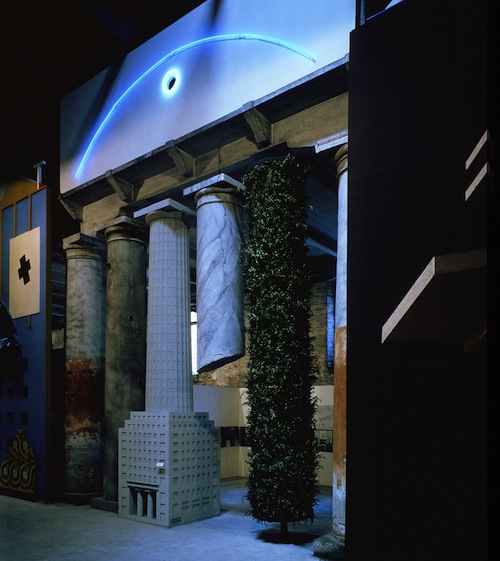 |
I’ve never really grasped the concept of postmodernism. It’s a vague term that I've always ignorantly considered synonymous with 80s flashiness. But while on vacation recently, I got an education on the movement—and its ties to and influence on my nearby Midwestern surroundings—after stopping by London's Victoria and Albert Museum to view its latest exhibit, Postmodernism: Style and Subversion 1970-1990 (through January 15, 2012).
I learned that my confusion was apt. It's as ambiguous as it sounds (even among artists): “Postmodernism was an unstable mix of the theatrical and theoretical. It was visually thrilling, a multifaceted style that ranged from the colourful to the ruinous, the ludicrous to the luxurious.” Of course, that was by design, or a lack thereof: “The modernists wanted to open a window onto a new world. Postmodernism, by contrast, was more like a broken mirror, a reflecting surface made of many fragments.”
Pruitt-Igoe and the End of Modernism
One of postmodernism’s inciting moments was the demolition of Pruitt-Igoe, an urban housing project in St Louis. Designed by architects George Hellmuth and Minoru Yamasaki (architect of the World Trade Center) in 1951, Pruitt-Igoe embodied the essence of modernism, an idealist's view of the world and how it should be structured. From The Economist:
The complex was supposed to put the modernist ideals of Le Corbusier into action; at the time, Architectural Forum ran a story praising the plan to replace “ramshackle houses jammed with people—and rats” in the city’s downtown with “vertical neighbourhoods for poor people."
The optimism surrounding Pruitt-Igoe faded as many residents moved out, leaving a complex that was marred by violence and crime.
Critics of modernist architecture were quick to seize on the design of the buildings, arguing that such forward-thinking features as skip-stop elevators, which stopped only at the first, fourth, seventh and tenth floors, were wholly unsuitable and ultimately dangerous. Designed to encourage residents to mingle in the long galleries and staircases, the elevators instead created perfect opportunities for muggings.
The project was viewed as a failure and the buildings began coming down in 1972. In his book The New Paradigm in Architecture: The Language of Post-Modernism, Charles Jencks hailed it as the end of modernity.
Modern Architecture died in St. Louis, Missouri on July 15, 1972 at 3.32 pm (or thereabouts) when the infamous Pruitt Igoe scheme, or rather several of its slab blocks, were given the final coup de grâce by dynamite. Previously it had been vandalized, mutilated and defaced by it inhabitants, and although millions of dollars were pumped back, trying to keep it alive (fixing the broken elevators, repairing smashed windows, repainting), it was finally put out of its misery. Boom, boom, boom.
The postmodernist critique of Pruitt-Igoe and similar public-housing developments has been challenged, most recently in the documentary The Pruitt-Igoe Myth. Defenders of the complex's design attribute Pruitt-Igoe's downfall to deeply rooted political, social, and economic structures. This debate reminds me of Chicago's own housing struggles, which Blair Kamin addresses in his 1995 Chicago Tribune article "Myth Must Be Exploded" (also republished in his book Why Architecture Matters: Lessons from Chicago).
The stereotype of a public-housing high-rise obscures a range of factors—location, interior layout, management structure, income mix and resident involvement—that spell the difference between a building that works and a boarded-up eyesore.
Kamin instead offers a nuanced analysis of public housing that touches not just on social policy but small, critical points of architecture, a contrast to Jenks's broad-based blast: which, despite its postmodern gloss of complexity, is a simplification that's prevented us from understanding the past. Nearly 40 years later, St. Louis is still trying to figure out how to learn from the project and move forward.
Since debuting at the Big Sky Documentary Film Festival in Montana earlier this year, The Pruitt-Igoe Myth has had several Midwest screenings. The next nearby screening is Tuesday, November 29th at the Missouri History Museum in St. Louis. (Update: Hyde Park Art Center is hosting a screening Wednesday, November 30th at 6 p.m.) Here's the trailer:
Tribune Tower: What Could Have Been
The exhibit also features this reconstruction of postmodernist Hans Hollein's façade from a 1980 exhibition at the Venice Biennale. The work blends the past with the present, using columns throughout history: the center column is a model of Austrian architect Adolf Loos's column-as-skyscraper, an entry into the Chicago Tribune's 1922 architecture competition for Tribune Tower. If you're curious what our skyline would've looked like with Loos's structure in it, check out this rendering [PDF] from Stuttgart University in Germany. This should resonate with any Chicagoan, particularly with those who, like myself, work at the Tower.

Stanley Tigerman
No look at Midwest postmoderism would be complete without a mention of Chicago architect Stanley Tigerman. Tigerman's The Titanic, featuring Mies Van Der Rohe's Crown Hall sinking into Lake Michigan, caused some stir. In Tigerman's 2011 book, Designing Bridges to Burn, architect Emmanuel Petit writes:
Stanley saw in the German emigré Mies van der Rohe his Oedipal (modern) alter ego. More voodoo doll than straw figure, however, Tigerman’s version of Mies was contrived to release Stanley from a spell, which he felt was cast on his generation of Chicago architects by the rigid universals and the zeitgeist ethic of (post-“Hellenic”) modernism. This father figure could not be killed, but had been set adrift in the endless ocean of the architectural subconscious of Stanley’s generation of (post)-modern Chicago architects—the Titanic, alias Mies, could not simply sink, but instead had to stay suspended on the ocean surface as the paragon of a modern belief system, whose framework has irretrievably been corroded.

During the 1980s, Tigerman was one of several architects asked to design tea and coffee sets for the Italian manufacturer Alessi and the now-defunct Swid Powell, among others. Many saw this as the unraveling of postmodernism, as the movement was hijacked by commodity culture. From the exhibit's accompanying book:
If buildings were already like trophies, operating accordinging to the dictates of corporate symbolic order, then the scaling-down of an architect's ideas did not necessarily represent an act of trivialization. Yet the Alessi services undeniably marked the culmination of a shift away from radical prototypes and toward luxury objects. Indeed, it could be said that these tabletop trophies were more a sign of things to come than the buildings made by the same architects.
For more on Tigerman's contribution to postmodernism and more, Ceci n'est pas une rêverie: The Architecture of Stanley Tigerman opens January 2012 at The Graham Foundation in Chicago.
Photographs: © V&A Images, Art Institute of Chicago


